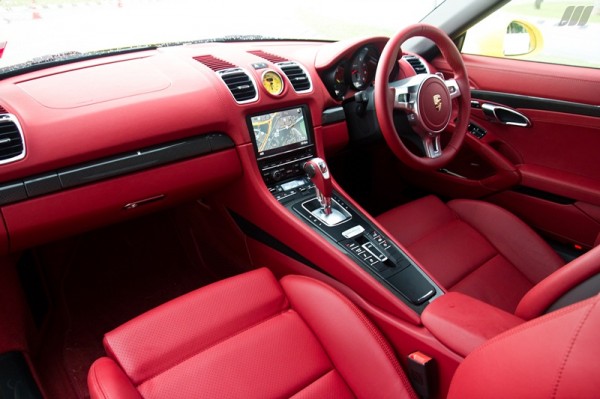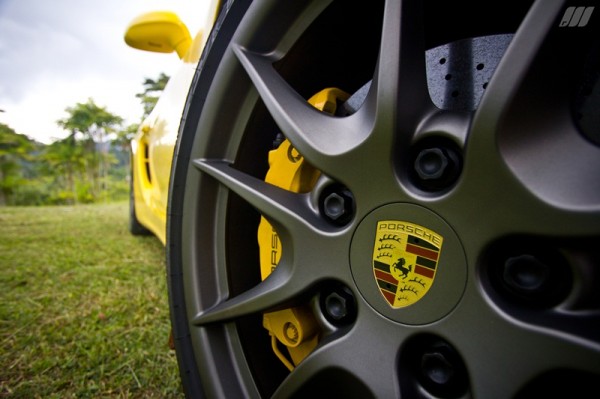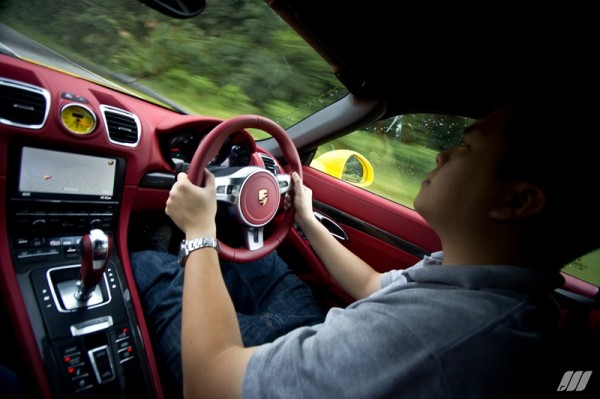The Boxster story is one that quite fascinates me; when Porsche launched the Boxster over a decade ago back in 1996, many thought that the car was meant to compete against roadsters from other marques – BMW’s Z3 and Mercedes’ SLK. Porsche instead had other much more serious intents, and designed the Boxster to be a low-cost, profitable sports car that could surpass the 911 in terms of sales. It was inspired by the 911, clearly, and even shared some common components. As the junior sports car in the line-up, Porsche hoped that it could attract a bigger market and bring an increase in sales. The Boxster did exactly that, even hauling the company out from financial red.
Our test unit for the day was the higher spec Boxster S that gets a 3.4-litre flat-six instead of the 2.7 in the non-S variant. This is the same engine that is used in the current base model Carrera, except tuned for 320PS/360Nm. There’s no doubt that the new car looks amazing – leaner and meaner than its predecessor, with definitive cues from the 991, Carrera GT, and even a sprinkle of the upcoming 918. Significant revisions include an all-new chassis construction, longer wheelbase, wider track, new roof mechanism, increased torsional rigidity, as well as extensive use of aluminum and magnesium to keep weight pared down.
On the inside, the Boxster joins the rest of the Porsche family – much improved over its predecessor’s lackluster interior. Fit and finish is standard Porsche fare, and while I might not agree with the car’s red hide, I will admit there are very few other cabins that I’d rather spend time in. Interior space is good and can easily fit two large adults, although the new car does lack stowage areas for your everyday bits and bobs: keys, mobile phone, etc. The cup-holders can’t even fit regular sized sodas. But enough about that because our goal today isn’t to find out the car’s limits at your local drive-thru; instead, we decide to try something different from our regular workflow, and head for the hills to test its sports car credentials.
When out on open roads, there’s really very little to fault the Boxster S. I’m not typically a fan of roadsters, but yet I couldn’t resist the urge to cruise with the top down. There’s good urgency too; mash on the accelerator and you feel the PDK dropping several gears, thrusting you into the seats as the speedometer climbs past legal highway speeds much too quickly. Power delivery in this car isn’t as brutal as a 911, but launching the car still brought a silly smirk on my face. The Boxster S gets the trick exhaust system too, Porsche’s Sound Symposer, which gives the exhaust a brilliant note, complete with crackly overruns. I strongly recommend trying this with the top down.
By default, the Boxster S gets the larger 21-inch wheels but ride quality remained supple and was never thrashy even over undulations on the roads. Switching from Normal to Sport or Sport Plus modes will yield a stiffer ride, as well as quickening up throttle response. The seven-speed PDK box deserves honourable mention here – it reacts so perceptively to variable driving conditions seamlessly so that you are able to focus completely on the road ahead of you. Porsche claims that the Boxster S will get from Zerotohundred in 5 seconds and despite our best efforts, we only managed low sub-five seconds. Porsche Carbon Ceramic Brakes (PCCB) are optional, and was fitted on our test car – like most ceramics, it lacked a little feel, but bites really hard when warmed up, with zero fade despite our constant punishment.
As we head up the hills, the brilliance of the Boxster package becomes more apparent. The car is incredibly fluid, beautifully balanced, with plenty of grip, and just the correct amount of power. Porsche Torque Vectoring (PTV) comes as standard on this car, aiding the Boxster through twisty corners by locking the mechanical rear differential that works with the individual rear brakes. Like the new 911, the all-new Boxster gets the electromechanical steering. True, this new system lacks some tactility and feedback by a slight margin, and I’ll admit that I don’t miss it. To me at least, there is welcome added refinement, with the steering sufficiently communicative and remaining razor sharp. This is the sort of car that bestows the driver with incredible confidence, allowing them to pilot the car to its very limits.
To me at least, there really is a lot to like with this car. The new styling does a fantastic job of keeping the Boxster current, and despite being bigger than before, manages to tip the scales lighter than its predecessor. Whilst the interior styling has had a dramatic change, it still remains familiar and still exudes a premium feel. There’s no trouble driving the Boxster S as an everyday car – there’s generous storage space from both front and rear trunks, the roof can be stowed or raised in just nine seconds at up to speeds of 60km/h… there’s even a start/stop system that allows ‘coasting’ (which thankfully could be turned off if desired). But the best part is that when you so demand, the Boxster S is capable of turning into a very able track machine; one that puts a smile on your face, and is closer than ever before to its 911 sibling.
For the naysayers, this is clear proof then, that Porsche is still capable of churning out damn fine sports cars.





































